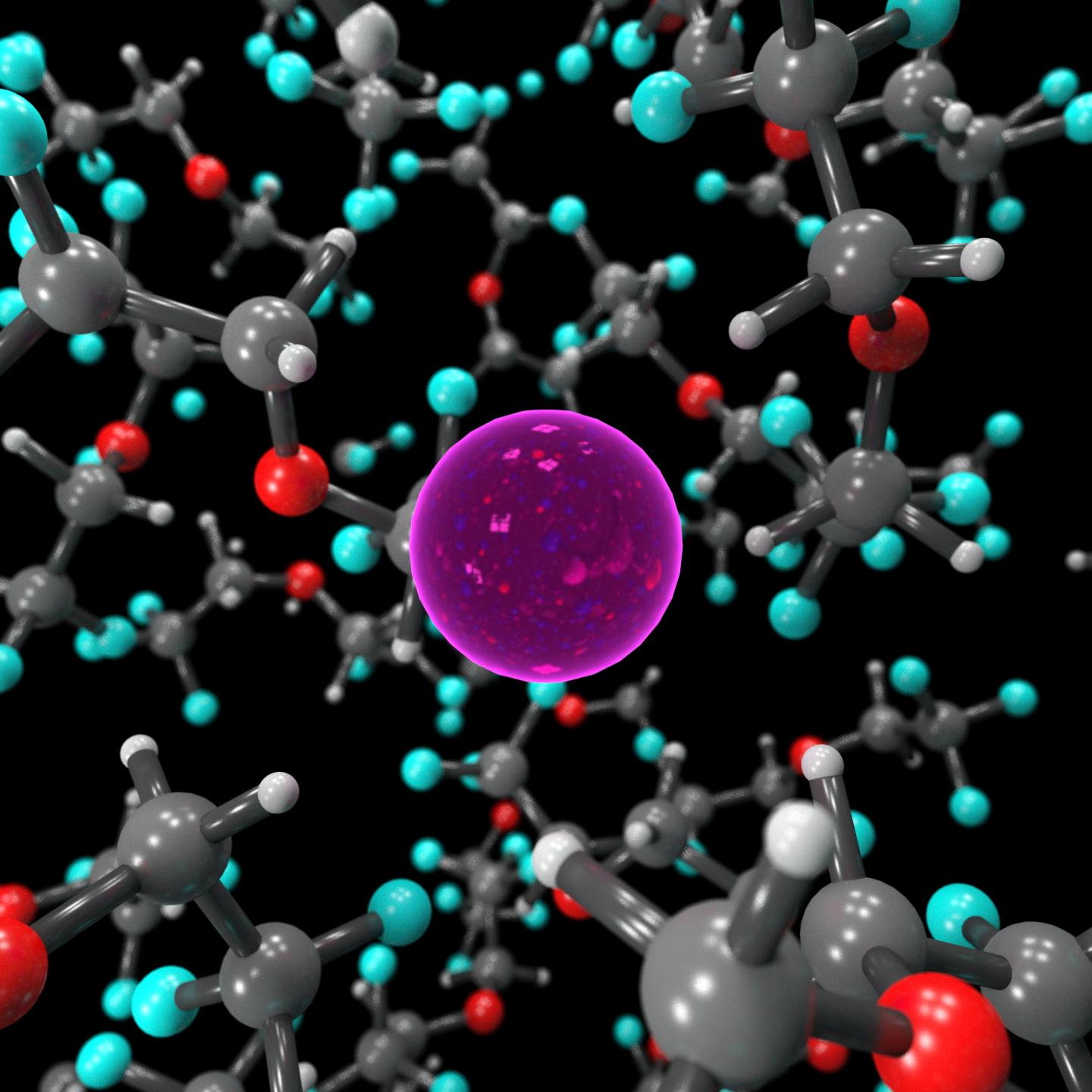
Credit: Purdue University image/Brett Savoie
WEST LAFAYETTE, Ind. — The chemical element that makes up most of today’s batteries, lithium, may soon be challenged by its polar opposite on the Periodic Table: fluoride. Yes, the same stuff in toothpaste.
The two elements would be in competition for helping electronics last longer on a charge, such as electric cars that need to travel more miles than is possible with lithium-ion batteries on the market.
Researchers are one step closer to equipping fluoride-based batteries for battle with improvements that allow the technology to operate at room temperature. Up until this point, fluoride had been limited to building high-temperature batteries that are impractical for our electronic devices.
A team of researchers at the Jet Propulsion Laboratory, the California Institute of Technology (Caltech), the Honda Research Institute, Inc. and Lawrence Berkeley National Laboratory – including a Caltech postdoctoral researcher who is now an assistant professor at Purdue University – has secured two U.S. patents for the improvements and published findings in the Dec. 6 issue of the journal Science.
Fluoride has long been in the running to trump lithium because of its potential for better energy storage in electrodes, which ions move between to charge a battery.
“Fluoride-based battery electrodes can store more ions per site than typical lithium-ion electrodes, which means that this technology has the capability to be much more energy dense,” said Brett Savoie, a Purdue assistant professor of chemical engineering.
Lithium and fluoride share a yin-and-yang relationship: lithium is the most electropositive element on the Periodic Table, meaning that it likes to lose electrons, while fluoride is the most electronegative element, only wanting to acquire electrons. Giving lithium electrons it doesn’t want stores energy, while taking electrons away from fluoride also stores energy.
To build a battery, the ions of elements like fluorine and lithium must dissolve into the battery’s electrolyte, a solution that helps them to travel between electrodes. The problem is that fluoride ions have only been able to dissolve well into solid electroyltes, limiting their use to high-temperature batteries.
For fluoride-based batteries to operate at room temperature, fluoride ions would need to dissolve better into a liquid electrolyte, like lithium ions do.
The technology could then move towards unseating lithium, a cation-based battery, as the first high-performing, anion-based rechargeable battery.
Researchers at the Jet Propulsion Laboratory discovered a liquid electrolyte, a synthesized molecule called BTFE, which allows fluoride to dissolve at room temperature. Savoie helped to make this discovery by simulating how BTFE and other related solvents successfully dissolve fluoride.
BTFE is made up of several chemical groups that are arranged to give the molecule two positively charged regions that strongly interact with fluoride, since opposites attract. Simulations showed how these charged regions lead BTFE molecules to surround fluoride and dissolve it at room temperature.
Savoie’s simulations also provided a mechanism for testing other solvents on fluoride, such as “glyme” molecules that expand the voltage and stability window of BTFE. This means that the battery would be less likely to fail at higher voltages.
The next step in beefing up fluoride-based batteries is extending the lifetimes of the positive and negative electrodes, called the cathode and anode. The team has already made some headway with this by stabilizing the copper cathode so that it doesn’t dissolve into the electrolyte.
Battery testing is underway. The work was supported by the Resnick Sustainability Institute and the Molecular Materials Research Center, both at Caltech, the National Science Foundation, the Department of Energy Office of Science and the Honda Research Institute.
This research also aligns with Purdue’s Giant Leaps celebration, acknowledging the university’s global advancements made toward a sustainable economy and planet as part of Purdue’s 150th anniversary. This is one of the four themes of the yearlong celebration’s Ideas Festival, designed to showcase Purdue as an intellectual center solving real-world issues.
###
ABSTRACT
Room-temperature cycling of metal fluoride electrodes: Liquid electrolytes for high-energy fluoride ion cells
Victoria K. Davis1, Christopher M. Bates1, Kaoru Omichi2, Brett M. Savoie1*,
Nebojša Momčilovi?1, Qingmin Xu2, William J. Wolf1, Michael A. Webb1,
Keith J. Billings1, Nam Hawn Chou2, Selim Alayoglu3, Ryan K. McKenney2,
Isabelle M. Darolles1, Nanditha G. Nair1, Adrian Hightower1, Daniel Rosenberg3,
Musahid Ahmed3, Christopher J. Brooks2, Thomas F. Miller III1,
Robert H. Grubbs1, Simon C. Jones1
1California Institute of Technology, Pasadena, CA, USA
2Honda Research Institute, Inc., Columbus, OH, USA
3Lawrence Berkeley National Laboratory, Berkeley, CA, USA
*Currently at Purdue University, West Lafayette, IN, USA
Fluoride ion batteries are potential “next-generation” electrochemical storage devices that offer high energy density. At present, such batteries are limited to operation at high temperatures because suitable fluoride ion-conducting electrolytes are known only in the solid state. We report a liquid fluoride ion-conducting electrolyte with high ionic conductivity, wide operating voltage, and robust chemical stability based on dry tetraalkylammonium fluoride salts in ether solvents. Pairing this liquid electrolyte with a copper-lanthanum trifluoride (Cu@LaF3) core-shell cathode, we demonstrate reversible fluorination and defluorination reactions in a fluoride ion battery electrochemical cell cycled at room temperature. Fluoride ion-mediated electrochemistry offers a pathway toward developing capacities beyond that of lithium ion technology.
Media Contact
Kayla Wiles
[email protected]
765-494-2432
Related Journal Article
http://dx.




